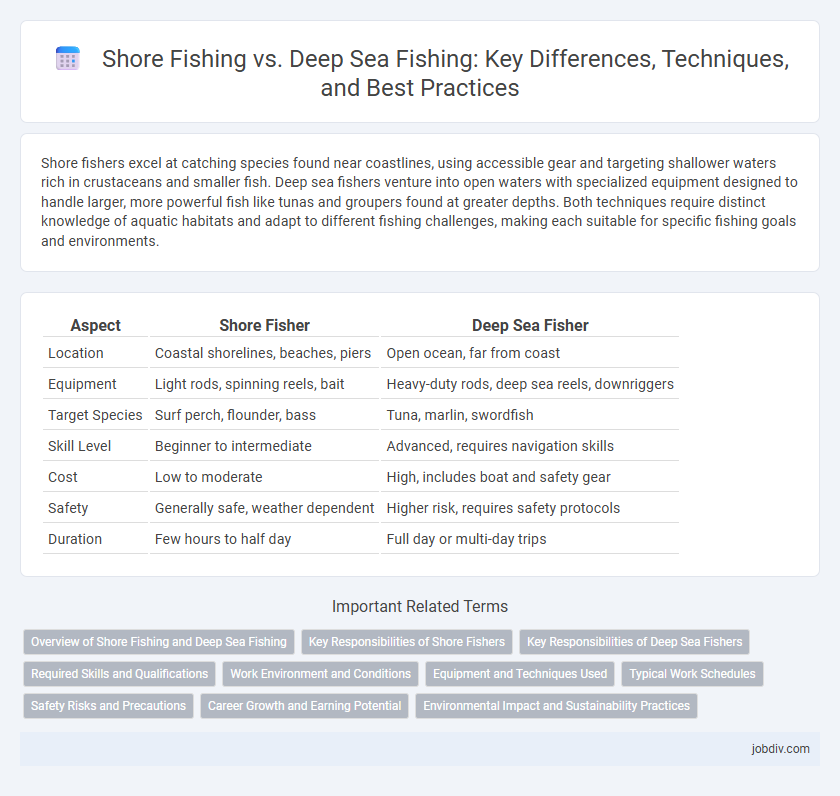Shore fishers excel at catching species found near coastlines, using accessible gear and targeting shallower waters rich in crustaceans and smaller fish. Deep sea fishers venture into open waters with specialized equipment designed to handle larger, more powerful fish like tunas and groupers found at greater depths. Both techniques require distinct knowledge of aquatic habitats and adapt to different fishing challenges, making each suitable for specific fishing goals and environments.
Table of Comparison
| Aspect | Shore Fisher | Deep Sea Fisher |
|---|---|---|
| Location | Coastal shorelines, beaches, piers | Open ocean, far from coast |
| Equipment | Light rods, spinning reels, bait | Heavy-duty rods, deep sea reels, downriggers |
| Target Species | Surf perch, flounder, bass | Tuna, marlin, swordfish |
| Skill Level | Beginner to intermediate | Advanced, requires navigation skills |
| Cost | Low to moderate | High, includes boat and safety gear |
| Safety | Generally safe, weather dependent | Higher risk, requires safety protocols |
| Duration | Few hours to half day | Full day or multi-day trips |
Overview of Shore Fishing and Deep Sea Fishing
Shore fishing involves casting lines from the coastline or shallow waters, targeting species like bass, mackerel, and flounder commonly found near docks, beaches, and rocky shores. Deep sea fishing occurs miles offshore in deeper waters, aiming for larger game fish such as tuna, marlin, and swordfish using specialized boats and heavy-duty gear. Both methods require distinct techniques, equipment, and knowledge of aquatic environments to maximize catch success.
Key Responsibilities of Shore Fishers
Shore fishers are responsible for selecting optimal coastal spots, using appropriate bait and tackle designed for species found in shallow waters, and monitoring tides and weather conditions to maximize catch efficiency. They must also maintain sustainable fishing practices by adhering to local regulations and minimizing environmental impact on marine ecosystems. Unlike deep sea fishers, shore fishers often work independently or in small groups, requiring strong knowledge of the shoreline's geography and fish behavior.
Key Responsibilities of Deep Sea Fishers
Deep sea fishers are responsible for navigating offshore waters, operating specialized vessels, and managing heavy-duty fishing equipment to target large, pelagic species such as tuna and swordfish. They must ensure compliance with maritime safety regulations and sustainable fishing practices while handling complex catch storage and preservation techniques. Their duties also include monitoring weather conditions, maintaining vessel and gear, and managing crew coordination during extended trips.
Required Skills and Qualifications
Shore fishing requires strong knowledge of local tides, fish species, and casting techniques, emphasizing patience and precise lure selection for varying water conditions. Deep sea fishing demands advanced navigation skills, knowledge of oceanography, and proficiency in handling heavy-duty equipment to manage larger fish and unpredictable weather. Both disciplines benefit from a solid understanding of fishing regulations and safety protocols, but deep sea fishing typically involves certifications in boat operation and marine safety.
Work Environment and Conditions
Shore fishing offers a stable environment with easy access to gear and frequent breaks, while deep sea fishing demands enduring rough seas, fluctuating weather, and extended hours on open water. Shore fishers benefit from predictable tides and comfortable terrain, contrasted by deep sea fishers who face challenges like intense physical labor, limited shelter, and exposure to stronger winds. The varying work conditions significantly impact equipment needs, safety protocols, and stamina requirements between these two fishing styles.
Equipment and Techniques Used
Shore fishing typically relies on lightweight rods, spinning reels, and bait such as worms or small fish, with techniques like casting and bottom fishing near the shoreline. Deep sea fishing requires heavy-duty rods, trolling reels, and specialized gear such as outriggers and downriggers, targeting larger species using techniques like trolling, jigging, and deep dropping. The choice of equipment and methods directly impacts success rates depending on the fishing environment and targeted fish species.
Typical Work Schedules
Shore fishermen typically work early mornings to late afternoons, capitalizing on tidal patterns and local fish activity near coastlines. Deep sea fishermen usually embark on longer trips, often lasting several days to weeks, requiring round-the-clock shifts due to the extended duration and remote fishing zones. Both schedules demand adaptability but differ significantly in time commitment and working hours based on fishing environments.
Safety Risks and Precautions
Shore fishing generally involves fewer safety risks due to stable ground and easier access to emergency help compared to deep sea fishing, which exposes anglers to hazards like rough waters, severe weather, and equipment failures far from shore. Deep sea fishermen must prioritize wearing life jackets, carrying emergency communication devices, and undergoing safety training to mitigate risks. Proper preparation and awareness of tide schedules and weather conditions are crucial precautions for both shore and deep sea fishing to ensure a safe experience.
Career Growth and Earning Potential
Shore fishing offers steady, accessible opportunities with moderate income potential largely dependent on local demand and seasonal variations. Deep sea fishing provides higher earning potential due to larger catches and commercial contracts, but requires significant experience, licensing, and investment in specialized equipment. Career growth in deep sea fishing is often faster and more lucrative, with roles expanding into vessel operation and commercial sales.
Environmental Impact and Sustainability Practices
Shore fishers typically have a lower environmental impact due to selective catch methods and reduced fuel consumption compared to deep sea fishing, which often involves large vessels using extensive nets that can damage marine habitats. Sustainable practices in shore fishing include catch-and-release techniques and seasonal restrictions to protect breeding cycles, while deep sea fisheries increasingly adopt quotas and bycatch reduction devices to mitigate ecological damage. Emphasizing localized management and compliance with international sustainability standards ensures the preservation of fish populations and marine biodiversity across both fishing methods.
Shore Fisher vs Deep Sea Fisher Infographic

 jobdiv.com
jobdiv.com